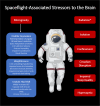A review of alterations to the brain during spaceflight and the potential relevance to crew in long-duration space exploration
- PMID: 33594073
- PMCID: PMC7887220
- DOI: 10.1038/s41526-021-00133-z
A review of alterations to the brain during spaceflight and the potential relevance to crew in long-duration space exploration
Abstract
During spaceflight, the central nervous system (CNS) is exposed to a complex array of environmental stressors. However, the effects of long-duration spaceflight on the CNS and the resulting impact to crew health and operational performance remain largely unknown. In this review, we summarize the current knowledge regarding spaceflight-associated changes to the brain as measured by magnetic resonance imaging, particularly as they relate to mission duration. Numerous studies have reported macrostructural changes to the brain after spaceflight, including alterations in brain position, tissue volumes and cerebrospinal fluid distribution and dynamics. Changes in brain tissue microstructure and connectivity were also described, involving regions related to vestibular, cerebellar, visual, motor, somatosensory and cognitive function. Several alterations were also associated with exposure to analogs of spaceflight, providing evidence that brain changes likely result from cumulative exposure to multiple independent environmental stressors. Whereas several studies noted that changes to the brain become more pronounced with increasing mission duration, it remains unclear if these changes represent compensatory phenomena or maladaptive dysregulations. Future work is needed to understand how spaceflight-associated changes to the brain affect crew health and performance, with the goal of developing comprehensive monitoring and countermeasure strategies for future long-duration space exploration.
Conflict of interest statement
The authors declare no competing interests.
Figures


Similar articles
-
Association of Structural Changes in the Brain and Retina After Long-Duration Spaceflight.JAMA Ophthalmol. 2021 Jul 1;139(7):781-784. doi: 10.1001/jamaophthalmol.2021.1400. JAMA Ophthalmol. 2021. PMID: 34014272 Free PMC article.
-
Changes in the Optic Nerve Head and Choroid Over 1 Year of Spaceflight.JAMA Ophthalmol. 2021 Jun 1;139(6):663-667. doi: 10.1001/jamaophthalmol.2021.0931. JAMA Ophthalmol. 2021. PMID: 33914020 Free PMC article.
-
NK cell function is impaired during long-duration spaceflight.J Appl Physiol (1985). 2019 Apr 1;126(4):842-853. doi: 10.1152/japplphysiol.00761.2018. Epub 2018 Nov 1. J Appl Physiol (1985). 2019. PMID: 30382809
-
Neuro-consequences of the spaceflight environment.Neurosci Biobehav Rev. 2022 Jan;132:908-935. doi: 10.1016/j.neubiorev.2021.09.055. Epub 2021 Nov 9. Neurosci Biobehav Rev. 2022. PMID: 34767877 Review.
-
The search for the ultimate exercise countermeasure to preserve crew health and ensure mission success in long-duration spaceflight.Exp Physiol. 2025 Feb 7. doi: 10.1113/EP091737. Online ahead of print. Exp Physiol. 2025. PMID: 39919033 Review.
Cited by
-
Formaldehyde initiates memory and motor impairments under weightlessness condition.NPJ Microgravity. 2024 Oct 28;10(1):100. doi: 10.1038/s41526-024-00441-0. NPJ Microgravity. 2024. PMID: 39468074 Free PMC article. Review.
-
Effects of long-term closed and socially isolating spaceflight analog environment on default mode network connectivity as indicated by fMRI.iScience. 2024 Mar 28;27(5):109617. doi: 10.1016/j.isci.2024.109617. eCollection 2024 May 17. iScience. 2024. PMID: 38660401 Free PMC article.
-
Adoption of microfluidic MEA technology for electrophysiology of 3D neuronal networks exposed to suborbital conditions.NPJ Microgravity. 2025 May 27;11(1):20. doi: 10.1038/s41526-025-00476-x. NPJ Microgravity. 2025. PMID: 40425594 Free PMC article.
-
Space Environment Impacts Homeostasis: Exposure to Spaceflight Alters Mammary Gland Transportome Genes.Biomolecules. 2023 May 22;13(5):872. doi: 10.3390/biom13050872. Biomolecules. 2023. PMID: 37238741 Free PMC article.
-
Space radiation damage rescued by inhibition of key spaceflight associated miRNAs.Nat Commun. 2024 Jun 11;15(1):4825. doi: 10.1038/s41467-024-48920-y. Nat Commun. 2024. PMID: 38862542 Free PMC article.
References
-
- Clark, J. B., Bacal K. in Principles of Clinical Medicine in Spaceflight Vol. 1 (ed Pool S. L. Barratt M. R.) (Springer, 2008).
-
- Bloomberg, J. J. et al. Evidence report: risk of impaired control of spacecraft/associated systems and decreased mobility due to vestibular/sensorimotor alterations associated with space flight, Technical Report No. JSC-CN-34446 (Houston, USA, 2015).
Publication types
LinkOut - more resources
Full Text Sources
Other Literature Sources

